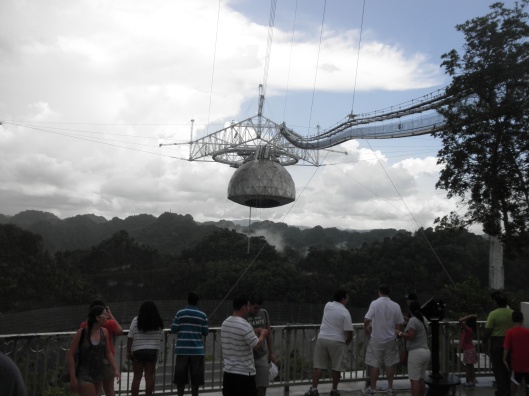Tags
Arecibo Observatory, astronaut ice cream, Goldeneye, largest telescope, Near Earth Object, Puerto Rico, radio telescope, SETI

After a long, rainy journey to Arecibo, Puerto Rico, Jose and Lillian Ortiz pose in front of the largest radio telescope in the world. Above their heads is a 900-ton reflector, which hangs 450-feet above a massive radio mirror.
Last month, Space Oddities celebrated a huge milestone – its one-year anniversary! Yah! While it has been difficult to write recently with new job responsibilities consuming much of my spare time, I try to soak in as much astronomy-related news as I possibly can.
And recently, I was treated to something extra special: An eight-day vacation to the beautiful island of Puerto Rico. Of course, the science gal in me had to visit the Arecibo Observatory to see the largest radio telescope in the world.
Our journey to Arecibo began at Rio Grande, PR, which is about 2.5 hours away from the observatory. My husband Jose and I thought it would be best to first visit the Camuy Caves and then make our way to the observatory. As luck would have it, our journey through unfamiliar land included intense rain while driving up winding and narrow roadways. It was quite the mini adventure, I thought. My husband, on the other hand, seemed more hesitant. I tried to distract him with some trivia: “Did you know the observatory was featured in the James Bond flick Goldeneye?” and “Contact (one of my favorite movies) was filmed in Arecibo … I think Fox Mulder made a visit to the observatory in an episode of the X-Files, too.”
It didn’t seem like my trivia calmed his nerves. Jose worried that we’d lose our way as our GPS unit didn’t work as well as we had hoped.
But every time we thought we were lost, we’d see a sign for the observatory and were immediately reassured that we were headed in the right direction. And at one point, up on a hill to the left, I saw three concrete towers, which immediately made me giggle with childlike exuberance. (Jose thought I lost it.) From all the research I had done before the trip, I knew that several hundred feet above the telescope’s huge reflecting surface – which covers 20-acres of land – is a 900-ton platform, which hangs midair from cables. Those cables are tied to … CONCRETE TOWERS! We were definitely close.
Ten minutes later, we made our way to the entrance of the National Astronomy and Ionosphere Center. At the gate, we were instructed on where to park our rented Ford Fiesta and also urged to turn off our cell phones as the signals omitting from the devices could interrupt the tests scientists were running. “No problem,” I said from the passenger side of car. As long as I could take pictures, I was fine.
After parking, we trekked our way up a huge hill that led to the visitor’s center. We were drenched from the rain, but nothing could get me down. We made it! (Jose and I never drive on our vacations. This was extra adventurous of us.)
We paid a $15 entrance fee and made our way through the hands-on exhibits, touched meteors and viewed model solar systems. Then it was time for a brief movie before heading out to view the massive telescope. I must admit, I felt bad for my husband. I think he was expecting to peer out into the universe, but this telescope wasn’t like that.
According to the observatory site:
With its radar vision, [the telescope] studies the properties of planets, comets and asteroids. In our galaxy, it detects the faint pulses emitted hundreds of times per second from pulsars. And from the farthest reaches of the universe, quasars and galaxies emit radio waves which arrive at Earth 100 million years later as signals so weak that they can only be detected by a giant eye like this one
The reflector is composed of almost 40,000 aluminum panels. It is unbelievably huge!
The first planets outside of our solar system and the first pulsar in a binary system was found using technology at the Arecibo Observatory. The telescope is able to search for signals of extraterrestrial life and it has helped in the detection of Near Earth Objects, or NEOs. In fact, last month scientists at the observatory discovered that asteroid 2012 LZ1 was twice as large as once believed. That asteroid could pose serious consequences to Earth if it did indeed collide with our planet. But don’t you worry. According to this article, we got another 750 years before that happens.
Here are some more accomplishments courtesy of the Arecibo Observatory.
After viewing the telescope, we stopped by the Galaxy Shop for souvenirs. I purchased some astronaut ice cream, which is freeze-dried, doesn’t need to be refrigerated and is ready to eat.
My husband and I saved the ice cream in our “End of the World” kit. 😉



